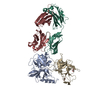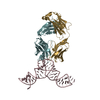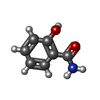+ Open data
Open data
- Basic information
Basic information
| Entry | Database: PDB / ID: 4k17 | |||||||||
|---|---|---|---|---|---|---|---|---|---|---|
| Title | Crystal Structure of mouse CARMIL residues 1-668 | |||||||||
 Components Components | Leucine-rich repeat-containing protein 16A | |||||||||
 Keywords Keywords | LIPID BINDING PROTEIN /  PH domain / PH domain /  LRR domain / LRR domain /  lipid binding / lipid binding /  protein-protein interaction / protein-protein interaction /  phosphatidylserine / phosphatidylserine /  phosphatidylinositol / phosphatidylinositol-5-phosphate / phosphatidylinositol / phosphatidylinositol-5-phosphate /  plasma membrane plasma membrane | |||||||||
| Function / homology |  Function and homology information Function and homology informationbarbed-end actin filament uncapping / positive regulation of lamellipodium organization / negative regulation of barbed-end actin filament capping /  macropinosome / actin filament network formation / macropinosome / actin filament network formation /  macropinocytosis / urate metabolic process / regulation of Arp2/3 complex-mediated actin nucleation / Factors involved in megakaryocyte development and platelet production / ruffle organization ...barbed-end actin filament uncapping / positive regulation of lamellipodium organization / negative regulation of barbed-end actin filament capping / macropinocytosis / urate metabolic process / regulation of Arp2/3 complex-mediated actin nucleation / Factors involved in megakaryocyte development and platelet production / ruffle organization ...barbed-end actin filament uncapping / positive regulation of lamellipodium organization / negative regulation of barbed-end actin filament capping /  macropinosome / actin filament network formation / macropinosome / actin filament network formation /  macropinocytosis / urate metabolic process / regulation of Arp2/3 complex-mediated actin nucleation / Factors involved in megakaryocyte development and platelet production / ruffle organization / intermediate filament cytoskeleton / macropinocytosis / urate metabolic process / regulation of Arp2/3 complex-mediated actin nucleation / Factors involved in megakaryocyte development and platelet production / ruffle organization / intermediate filament cytoskeleton /  lamellipodium assembly / establishment or maintenance of cell polarity / positive regulation of actin filament polymerization / cell leading edge / filamentous actin / positive regulation of substrate adhesion-dependent cell spreading / positive regulation of stress fiber assembly / lamellipodium assembly / establishment or maintenance of cell polarity / positive regulation of actin filament polymerization / cell leading edge / filamentous actin / positive regulation of substrate adhesion-dependent cell spreading / positive regulation of stress fiber assembly /  cell migration / cell migration /  lamellipodium / positive regulation of cell migration / nuclear speck / protein-containing complex binding / lamellipodium / positive regulation of cell migration / nuclear speck / protein-containing complex binding /  nucleoplasm / nucleoplasm /  nucleus / nucleus /  plasma membrane / plasma membrane /  cytosol / cytosol /  cytoplasm cytoplasmSimilarity search - Function | |||||||||
| Biological species |   Mus musculus (house mouse) Mus musculus (house mouse) | |||||||||
| Method |  X-RAY DIFFRACTION / X-RAY DIFFRACTION /  SYNCHROTRON / SYNCHROTRON /  SAD / Resolution: 2.895 Å SAD / Resolution: 2.895 Å | |||||||||
 Authors Authors | Zwolak, A. / Dominguez, R. | |||||||||
 Citation Citation |  Journal: Nat Commun / Year: 2013 Journal: Nat Commun / Year: 2013Title: CARMIL leading edge localization depends on a non-canonical PH domain and dimerization. Authors: Zwolak, A. / Yang, C. / Feeser, E.A. / Michael Ostap, E. / Svitkina, T. / Dominguez, R. | |||||||||
| History |
|
- Structure visualization
Structure visualization
| Structure viewer | Molecule:  Molmil Molmil Jmol/JSmol Jmol/JSmol |
|---|
- Downloads & links
Downloads & links
- Download
Download
| PDBx/mmCIF format |  4k17.cif.gz 4k17.cif.gz | 503.6 KB | Display |  PDBx/mmCIF format PDBx/mmCIF format |
|---|---|---|---|---|
| PDB format |  pdb4k17.ent.gz pdb4k17.ent.gz | 418.8 KB | Display |  PDB format PDB format |
| PDBx/mmJSON format |  4k17.json.gz 4k17.json.gz | Tree view |  PDBx/mmJSON format PDBx/mmJSON format | |
| Others |  Other downloads Other downloads |
-Validation report
| Arichive directory |  https://data.pdbj.org/pub/pdb/validation_reports/k1/4k17 https://data.pdbj.org/pub/pdb/validation_reports/k1/4k17 ftp://data.pdbj.org/pub/pdb/validation_reports/k1/4k17 ftp://data.pdbj.org/pub/pdb/validation_reports/k1/4k17 | HTTPS FTP |
|---|
-Related structure data
| Similar structure data |
|---|
- Links
Links
- Assembly
Assembly
| Deposited unit | 
| ||||||||
|---|---|---|---|---|---|---|---|---|---|
| 1 | 
| ||||||||
| 2 | 
| ||||||||
| 3 | 
| ||||||||
| 4 | 
| ||||||||
| Unit cell |
|
- Components
Components
| #1: Protein | Mass: 74778.203 Da / Num. of mol.: 4 / Fragment: PH and LRR domains (UNP residues 1-668) Source method: isolated from a genetically manipulated source Source: (gene. exp.)   Mus musculus (house mouse) / Gene: Carmil, Lrrc16, Lrrc16a / Plasmid: pRSFDuet-1 / Production host: Mus musculus (house mouse) / Gene: Carmil, Lrrc16, Lrrc16a / Plasmid: pRSFDuet-1 / Production host:   Escherichia coli (E. coli) / Strain (production host): BL21 RIPL / References: UniProt: Q6EDY6 Escherichia coli (E. coli) / Strain (production host): BL21 RIPL / References: UniProt: Q6EDY6#2: Chemical | ChemComp-OHB / |  Salicylamide Salicylamide#3: Chemical | ChemComp-CL / |  Chloride Chloride#4: Chemical | ChemComp-ABU / |  Γ-Aminobutyric acid Γ-Aminobutyric acid |
|---|
-Experimental details
-Experiment
| Experiment | Method:  X-RAY DIFFRACTION / Number of used crystals: 1 X-RAY DIFFRACTION / Number of used crystals: 1 |
|---|
- Sample preparation
Sample preparation
| Crystal | Density Matthews: 2.56 Å3/Da / Density % sol: 51.92 % |
|---|---|
Crystal grow | Temperature: 293 K / Method: vapor diffusion, hanging drop / pH: 7.7 Details: 16 % PEG3350, 130 mM lithium sulfate, 0.25 % w/v salicylamide, pH 7.7, VAPOR DIFFUSION, HANGING DROP, temperature 293K |
-Data collection
| Diffraction | Mean temperature: 100 K |
|---|---|
| Diffraction source | Source:  SYNCHROTRON / Site: SYNCHROTRON / Site:  NSLS NSLS  / Beamline: X6A / Wavelength: 0.9784 Å / Beamline: X6A / Wavelength: 0.9784 Å |
| Detector | Type: ADSC QUANTUM 270 / Detector: CCD / Date: Aug 4, 2012 / Details: toroidal focusing mirror |
| Radiation | Monochromator: Si(111) channel cut / Protocol: SINGLE WAVELENGTH / Monochromatic (M) / Laue (L): M / Scattering type: x-ray |
| Radiation wavelength | Wavelength : 0.9784 Å / Relative weight: 1 : 0.9784 Å / Relative weight: 1 |
| Reflection | Resolution: 2.895→50 Å / Num. all: 65054 / Num. obs: 63752 / % possible obs: 98 % / Observed criterion σ(F): 2 / Observed criterion σ(I): 2 / Redundancy: 8 % / Rmerge(I) obs: 0.124 / Net I/σ(I): 13.8 |
| Reflection shell | Resolution: 2.895→3 Å / Redundancy: 7.4 % / Rmerge(I) obs: 0.825 / Mean I/σ(I) obs: 1.8 / % possible all: 84.4 |
- Processing
Processing
| Software |
| ||||||||||||||||||||
|---|---|---|---|---|---|---|---|---|---|---|---|---|---|---|---|---|---|---|---|---|---|
| Refinement | Method to determine structure : :  SAD / Resolution: 2.895→49.759 Å / Cor.coef. Fo:Fc: 0.9048 / σ(F): 2 / Stereochemistry target values: Engh & Huber SAD / Resolution: 2.895→49.759 Å / Cor.coef. Fo:Fc: 0.9048 / σ(F): 2 / Stereochemistry target values: Engh & Huber
| ||||||||||||||||||||
| Refinement step | Cycle: LAST / Resolution: 2.895→49.759 Å
| ||||||||||||||||||||
| Refine LS restraints |
|
 Movie
Movie Controller
Controller











 PDBj
PDBj













